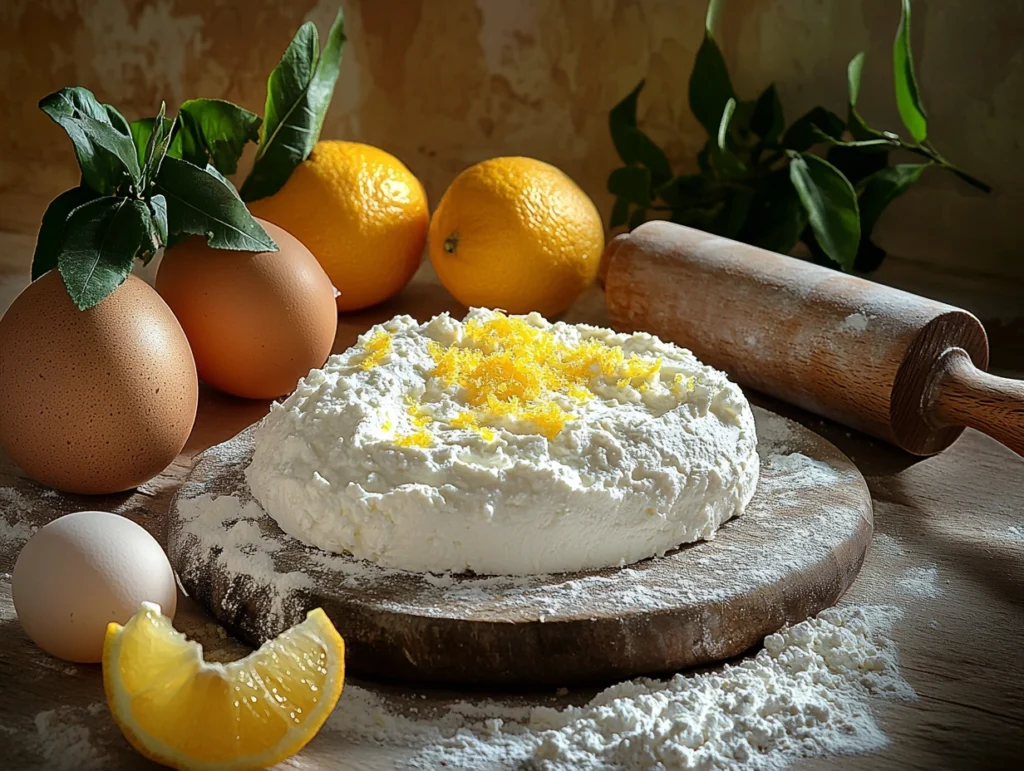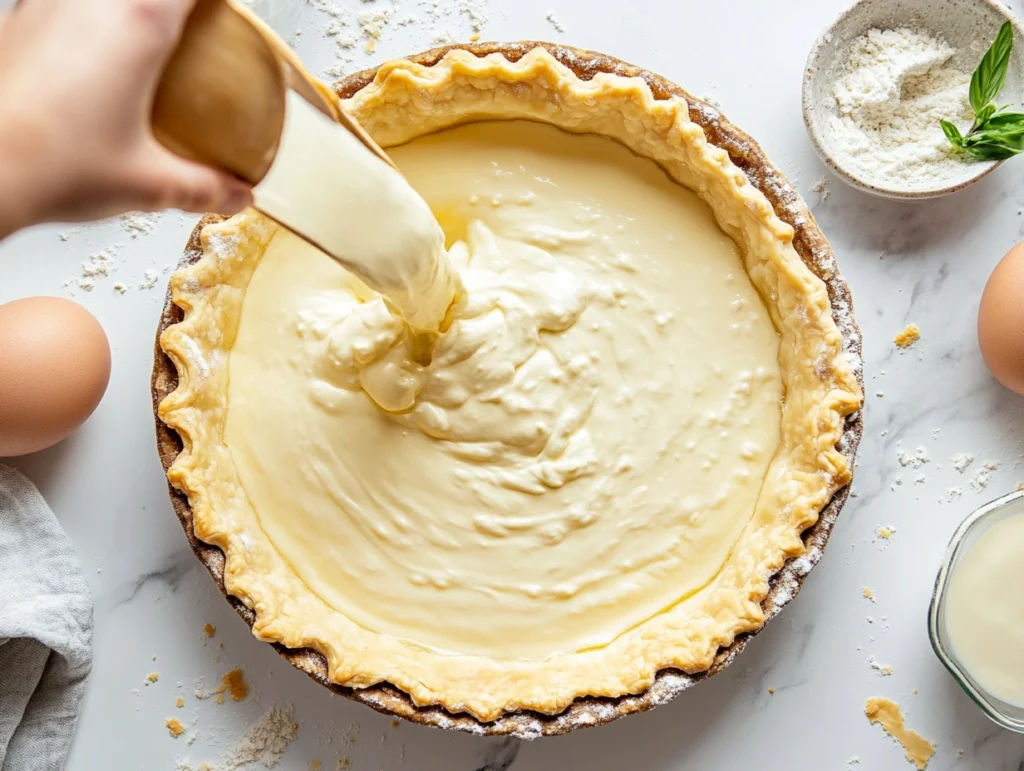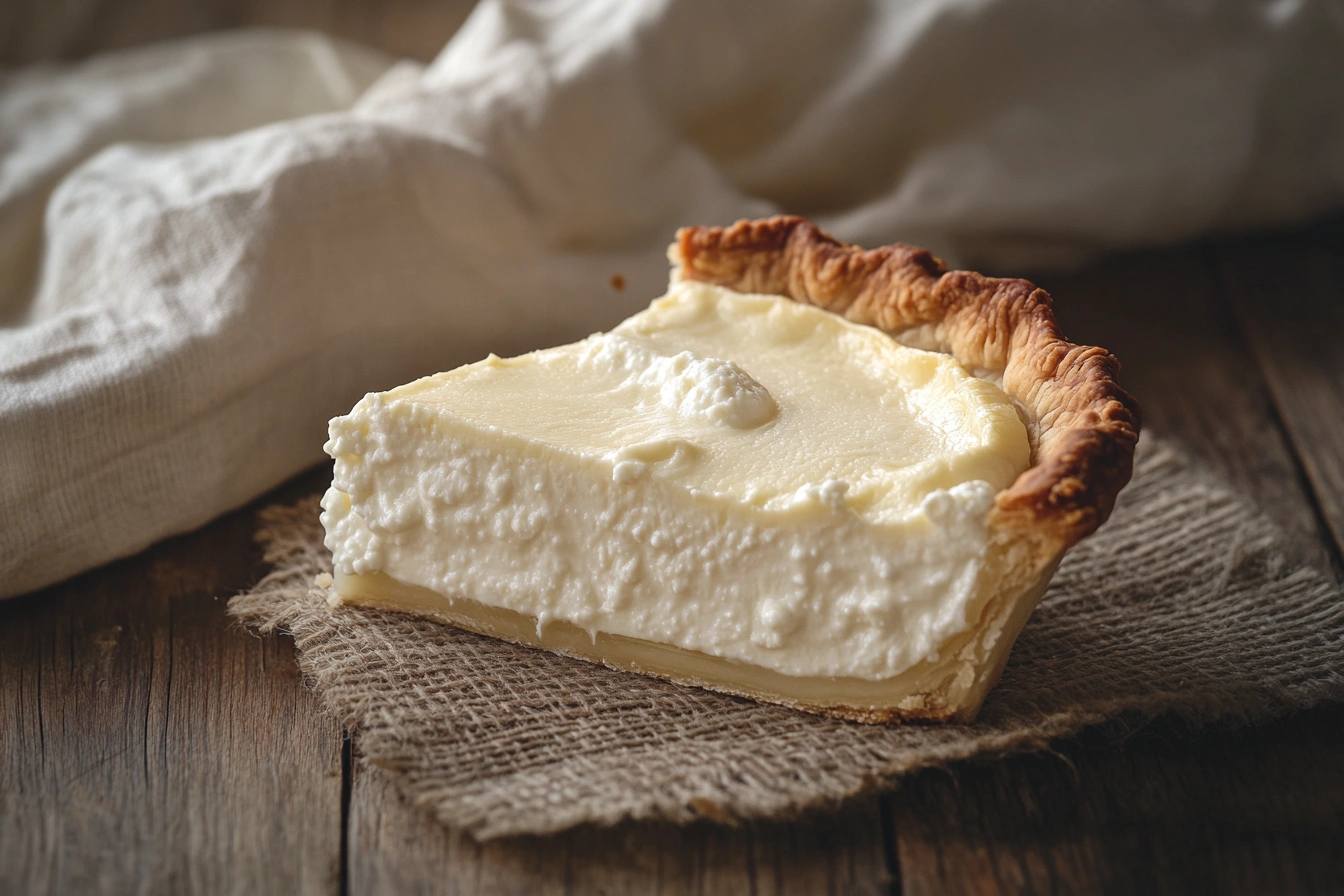Imagine savoring a dessert that feels airy, tastes delicately sweet, and brings you straight into the heart of a cherished Italian family kitchen. Indeed, this entire article reveals everything about the wonderfully creamy, old-fashioned ricotta cheese pie and its delicious variations. While some may think only of overly sugary cakes or puddings, this Italian-inspired treat delivers a fluffy, gently sweetened filling wrapped in a delightful flaky crust. Although many people have enjoyed such pies for generations, few truly understand their origins, ingredients, and best methods of preparation. In the upcoming sections, we’ll dive into its cultural roots, essential ingredients, baking tips, and serving suggestions. Let’s begin and enjoy a culinary journey packed with authenticity, charm, and unexpected flavor twists.
Part 1: Introduction and Background
Understanding the Classic Ricotta Cheese Pie Tradition
Without a doubt, ricotta cheese pie remains one of the most treasured Italian-inspired desserts found in many American-Italian homes. Moreover, it captures the spirit of traditional Italian baking by combining fresh dairy and a pleasantly light texture. Interestingly, individuals preparing this pie often recall warm memories of family gatherings and whispered kitchen secrets passed down through generations. Although variations emerge from different regions, the core idea persists: fresh ricotta, subtle sweetness, and a delicate pastry shell form an irresistible dessert that quietly outshines many standard treats. Essentially, this Italian ricotta pie’s simple ingredients produce extraordinary flavors when handled gently.
Discovering the Traditional Roots of Ricotta Cheese Pie
Historically, Italian cooks relied on dairy products in countless baked goods, and torta di ricotta has graced countless holiday tables. Indeed, ricotta cheese pie likely emerged in Southern Italy, where abundant sunshine and fertile land encouraged a milk-rich cuisine. In fact, Italians created numerous pastries infused with fresh cheese, citrus zest, and vanilla long before today’s global dessert scene took shape. Meanwhile, immigrants carried these traditions to America, blending old-world elegance with new-world ingredients. Although times changed, this dessert’s essence remained intact, delighting palates with a creamy ricotta filling that, when combined with a homemade pastry crust, nods to a culinary heritage that refuses to fade away.
Embracing the Unique Flavor of Ricotta Cheese Pie
Undeniably, the experience of tasting ricotta cheese pie differs from biting into a heavily iced cake or a hyper-sweet confection. Instead, it offers a gentle sweetness and a melt-in-your-mouth, creamy ricotta filling that pairs beautifully with subtle hints of vanilla or lemon zest. Furthermore, a flaky pastry crust encases this filling, adding a balanced contrast in both texture and flavor. Interestingly, the pie’s flavor profile often depends on personal flair: some bakers add chocolate chips or orange zest, while others prefer only pure, classic simplicity. Nevertheless, the light, fluffy texture and mild sweetness ensure that each bite feels comforting rather than cloying. In truth, this dessert encourages mindful savoring rather than rushed indulgence.
Highlighting Nutritional Aspects of Ricotta Cheese Pie
Certainly, choosing a dessert that offers moderate nutritional benefits rather than empty calories can seem tricky. While ricotta cheese pie remains a sweet treat, its core ingredient—ricotta—provides protein and calcium. Granted, it’s still a dessert, so moderation counts, but this pie often feels a bit lighter and more wholesome than many counterparts. In particular, ricotta’s richness comes with fewer unhealthy fats than certain dense cheesecakes. Additionally, lemon zest or orange zest imparts subtle brightness without piling on sugar. By choosing fresh, high-quality ingredients and savoring reasonable portions, individuals can enjoy a slice of this American-Italian dessert while respecting their well-being. It’s true that careful preparation and mindful consumption turn each piece into something special rather than an overindulgence.
Overall, ricotta cheese pie weaves together heritage, flavor, and thoughtful ingredient choices, ensuring that its presence will remain strong on tables for generations to come.
Part 2: Ingredients and Preparations
Choosing the Best Ricotta Cheese for Your Ricotta Cheese Pie
When you think about a proper ricotta cheese pie, fresh dairy quality matters more than anything else. In fact, top-notch ricotta cheese transforms a standard dessert into a delicate, creamy marvel. Although supermarket shelves may carry a few ricotta brands, it’s worth scouting for that perfect artisanal option. Moreover, fresh ricotta yields a smooth, pleasantly mild flavor with far fewer gritty bits. You’ll notice that a premium variety possesses a gentle sweetness and a fluffy consistency, rather than a dense or chalky feel. Certainly, removing excess moisture before blending ensures that the filling won’t turn soupy. Strain it overnight in the fridge, letting liquid drip away and leaving you with a luxurious, thick base for your Italian ricotta pie. By choosing a dairy-rich foundation with subtle freshness and balancing tanginess, you’ll create a dessert that exceeds expectations and stands up to Nonna’s scrutiny.

Essential Ingredients for an Exceptional Ricotta Cheese Pie
Naturally, a fabulous ricotta cheese pie calls for a handful of key ingredients that complement one another. You’ll need ricotta cheese, sugar, fresh eggs, and vanilla extract—these items deliver the creamy, custard-like center. However, consider adding citrus zest, like lemon or orange, since it provides brightness and depth. Oh, and if you crave complexity, toss in a whisper of cinnamon or nutmeg. Furthermore, a few chocolate chips can lend a subtle sweetness, while a spoonful of honey can deliver a faint floral note. In addition, a pinch of salt can intensify flavors, ensuring that your torta di ricotta doesn’t taste monotonous. A balanced blend of top-quality ingredients guarantees that this Italian cheesecake alternative feels both comforting and refined. With such care and finesse, your ricotta dessert recipe emerges light, rich, and entirely crave-worthy.
Selecting and Preparing the Crust for Your Ricotta Cheese Pie
Though the filling often steals the spotlight, the crust forms the essential stage on which your ricotta cheese pie performs. Interestingly, a homemade pastry crust makes a noticeable difference—its flaky texture and buttery aroma enhance each creamy bite. While store-bought options do exist, putting in the extra effort to prepare a homemade pastry crust is well worth it. Begin with cold butter or a quality plant-based alternative, plus all-purpose flour, a pinch of salt, and a spoonful or two of sugar. Work these together using a pastry cutter or your fingertips, but be careful not to overdo it. After forming a shaggy dough, gently gather it into a disk and let it chill before rolling it out. Once it’s rolled, fit it into your pie dish, pressing lightly to avoid tears. Indeed, don’t skip blind baking: place parchment and pie weights on top, and bake it briefly to set the structure. By securing a sturdy base, you ensure your creamy ricotta filling won’t create a soggy bottom. In short, a crisp, flaky crust meets velvety filling, sparking a flavor fusion nobody can resist.
Equipment You’ll Need to Perfect Your Ricotta Cheese Pie
Before whipping up your ricotta cheese pie, make sure you have the right tools to streamline the process. A quality mixing bowl—preferably stainless steel or glass—and a sturdy whisk or electric mixer ensure a lump-free mixture. Oh, and a well-sized pie dish, whether ceramic or metal, will influence how evenly the crust browns. Additionally, a fine mesh sieve or cheesecloth serves as a handy tool for draining ricotta, ensuring a thick and creamy base. A microplane zester easily extracts bright citrus oils, while a silicone spatula helps scrape every last bit of filling from the bowl. After baking, a cooling rack encourages even airflow, preventing sweat and sogginess. Meanwhile, a sharp, thin-bladed knife slices through each chilled wedge neatly. In essence, preparing the right equipment involves more than convenience—it’s about mastering a method that keeps flavors shining. With these essentials at hand, you’ll handle each step of the process smoothly, leaving no room for fuss or disappointment.
In the end, by selecting high-quality dairy, layering nuanced ingredients, crafting a tender crust, and assembling an efficient toolkit, you’re well on your way to creating a ricotta cheese pie that both enchants and excites. Though simple, these preparations lay the foundation for something outstanding. Next, we’ll roll up our sleeves and dive into the step-by-step instructions and popular variations that keep this enduring dessert forever enticing.
Part 3: Step-by-Step Instructions and Popular Variations
Creating the Classic Ricotta Cheese Pie—A Foolproof Ricotta Dessert Recipe
Ready to transform your carefully chosen ingredients into a stunning ricotta cheese pie? First, roll your chilled dough into a round, gently pressing it into your greased pie dish. Make sure to trim any overhang, then blind bake it with pie weights for a bit until the crust starts firming up. Meanwhile, whip your drained ricotta cheese together with sugar, eggs, a dash of vanilla, and a hint of citrus zest. This combination should form a silky batter that feels glossy yet light. Carefully pour it into your partially baked crust, smoothing the top with a spatula. Pop the pie back into the oven, and watch as the filling puffs and sets. When it’s mostly firm but still ever so slightly jiggly in the center, remove it. Let it rest on a cooling rack until it reaches room temperature, then store it in the fridge for a few hours. Eventually, slice through that luscious center, tasting how the creamy layers and flaky pastry beautifully merge. Boom—your Italian ricotta pie masterpiece awaits.
Differentiating Sweet vs. Savory Ricotta Cheese Pie Variations
Now that you’ve nailed the traditional approach, why not explore slightly bolder paths? Sure, the standard ricotta cheese pie leans sweet, often adorned with sugar, vanilla, and subtle citrus notes. Yet, think outside the box: a savory take exists, too. Skip the sugar and vanilla, and instead fold in herbs like fresh basil or chives, along with sautéed spinach or sun-ripened tomatoes. This savory rendition surprises your palate with a completely different vibe that works as a brunch dish or a light lunch, rather than a dessert. Indeed, torta di ricotta can shift seamlessly between sweet and savory realms, satisfying different cravings with minimal fuss.
Popular Regional Takes on Ricotta Cheese Pie—Exploring Torta di Ricotta Styles
Dig deeper into Italian-American traditions, and you’ll encounter a gallery of regional twists on ricotta cheese pie. Southern Italian Easter pies sometimes include wheat berries or candied citrus, thus creating a heartier texture with a whisper of old-world charm. In other regions, bakers add minced dried fruit—like apricots or figs—or garnish the top with almond slivers. Sicilian-inspired versions may incorporate aromatic orange blossom water or citrus zest, while others rely on chocolate chips to please modern palates. These unique adjustments honor ancestral roots and allow today’s cooks to breathe fresh life into a time-honored dessert. Ultimately, the possibilities stretch far beyond the standard formula, ensuring you never grow bored.

Experimenting with Creative Twists on Your Ricotta Cheese Pie
If you crave adventure, take this ricotta dessert recipe further by adding a thin layer of jam—perhaps apricot or raspberry—at the crust’s bottom. Such a fruity surprise heightens complexity and gives each bite an unexpected tang. Alternatively, a pinch of cinnamon or cardamom introduces exotic warmth, while a dusting of cocoa powder lends subtle richness. Want more texture? Stir in a handful of toasted nuts or swirl in chunks of high-quality dark chocolate. Furthermore, a sprinkle of powdered sugar over the cooled pie not only looks picture-perfect, but also provides a delightful finishing touch. Yes, these tiny tweaks keep your Italian ricotta pie evolving, each iteration capturing a new moment of culinary creativity.
With each variation or personal spin, you uncover another dimension of ricotta cheese pie. This dessert welcomes inventiveness, never limiting itself to a single approach. At the core, you’ll still find that creamy, slightly sweet ricotta goodness, but around it, endless customization awaits. In the next part, we’ll discuss how to serve, store, and troubleshoot, ensuring your ricotta cheese pie remains a reliable crowd-pleaser in any situation.
Part 4: Serving, Storing, and Additional Tips
How to Serve Your Ricotta Cheese Pie for Maximum Delight
Once your ricotta cheese pie has fully chilled and set, think about how to heighten its appeal. Rather than serving it straight from the fridge, consider letting it rest at room temperature for a short while. This pause allows the filling’s flavors to bloom, revealing a gentle sweetness and that light, creamy ricotta texture. Although it stands strongly on its own, a spoonful of whipped cream or a scattering of fresh fruit can add extra contrast. Also, try drizzling a touch of honey on top, giving each slice an unexpected depth that never feels cloying. With just a few small tweaks, your ricotta dessert recipe emerges more polished, inviting everyone to savor each forkful.
Tips for Storing and Prolonging Freshness of Your Ricotta Cheese Pie
If by some miracle you have leftovers, store the remaining ricotta cheese pie in the refrigerator, lightly covered to prevent it from drying out. Consuming it within a few days ensures the best flavor and texture, though you can stretch it to three or four days if needed. Freezing individual slices is also possible, provided you wrap them tightly in plastic wrap and place them in an airtight container. Thaw them gently in the fridge before serving, never rushing the process, to maintain the pie’s creamy goodness. By following these steps, you ensure that no slice goes to waste and that every subsequent taste matches the first.
Troubleshooting Common Ricotta Cheese Pie Issues and Finding Quick Fixes
Though mastering a ricotta cheese pie seems straightforward, occasional hiccups might appear. If the filling cracks, you may have baked it slightly too long. Next time, reduce the baking time and remove the pie while it still retains a slight jiggle. On the other hand, if the center appears watery, it could mean the ricotta wasn’t sufficiently drained. Next batch, strain it overnight to achieve that creamy density. A soggy crust likely indicates the need for a more thorough blind baking. Remember, small adjustments fix most pitfalls. Every stumble teaches you how to fine-tune your approach, ultimately leading to a perfected Italian ricotta pie that leaves guests speechless.
Extra Tips to Achieve Perfection and Elevate Your Ricotta Cheese Pie
While perfecting your ricotta cheese pie, taste-testing the filling before baking ensures you get the sweetness and balance right. Don’t shy away from subtle flavor enhancers—citrus zest, a pinch of salt, or even a light dash of cinnamon can change everything. Gently folding the filling reduces air bubbles and leads to a smoother surface. Furthermore, slicing the pie with a warm, sharp knife creates neat wedges that look beautiful on the plate. Although these seem like minor details, all these efforts combine to present an experience that feels downright indulgent. By paying attention to subtle aspects, you produce a ricotta dessert recipe that radiates confidence and finesse.
In the upcoming section, we’ll tackle the FAQs you’ve requested, shedding more light on common queries that arise when baking and enjoying ricotta cheese pie. After that, a brief conclusion will wrap up our culinary journey.
FAQs
Frequently Asked Questions about Ricotta Cheese Pie
What does ricotta cheese pie taste like?
A traditional ricotta cheese pie delivers a mild, creamy flavor that’s subtly sweet and light. It often tastes less sugary than a typical cheesecake and features a delicate dairy freshness, plus a hint of citrus zest or vanilla. Overall, it feels both comforting and pleasantly mellow without overwhelming your palate.
How is ricotta cheese pie different from cheesecake?
While both desserts rely on dairy, cheesecake typically uses cream cheese and often tastes richer and denser. On the other hand, ricotta cheese pie employs fresh ricotta, which creates a lighter, fluffier filling. Additionally, the crust and sweetness level may differ, making this Italian-inspired treat gentler and more refined.
Should I drain the ricotta before making ricotta cheese pie?
Absolutely. Draining the ricotta helps remove excess moisture and prevents the filling from turning watery. Straining it through cheesecloth or a fine mesh sieve overnight allows the mixture to thicken, ensuring a silky, creamy pie that sets nicely and avoids a runny center.
Can I adjust the sweetness level in my ricotta cheese pie?
Certainly. Taste-test your filling before baking and tweak the sugar level to suit your preferences. Some individuals prefer a more subtle sweetness, while others appreciate a slightly sweeter bite. Experimentation helps you strike the perfect balance for your taste buds.
How do I keep the crust from getting soggy?
Blind baking the crust partially before adding the filling helps firm it up, preventing moisture from seeping into the dough. Ensuring that the ricotta mixture is properly drained and not overly liquid also keeps the crust crisp and flaky.
How long does ricotta cheese pie stay fresh?
Stored properly in the refrigerator, covered gently, ricotta cheese pie maintains excellent flavor and texture for up to three or four days. After that, the quality may decline slightly. Freezing individual slices extends shelf life, but always thaw them slowly in the fridge for the best results.
Conclusion:
Ricotta cheese pie captures a legacy of culinary tradition, blending fresh dairy, delicate sweetness, and a buttery crust. By carefully choosing quality ingredients, mastering simple techniques, and personalizing the flavors, you’ll serve a dessert that transcends trends. Whether it’s a holiday celebration or a quiet family gathering, each creamy slice reflects warmth, authenticity, and the timeless pleasure of a classic Italian-inspired treat.

